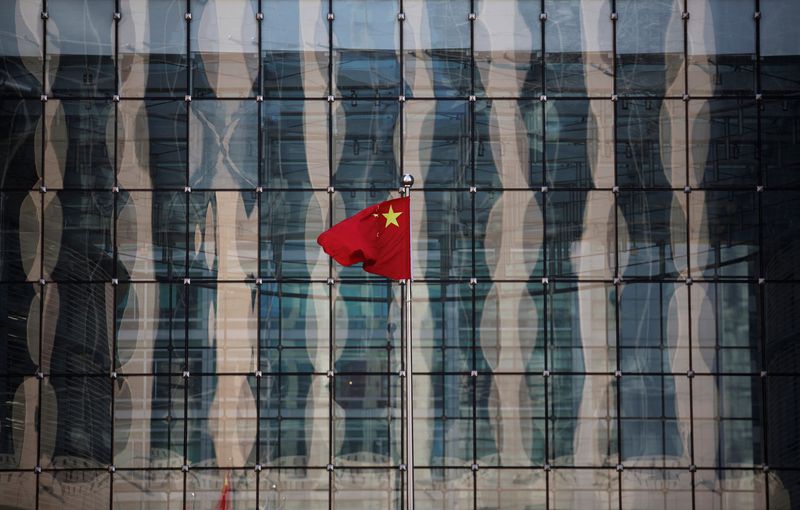(Reuters) -Ratings agency Moody's (NYSE:MCO) slapped a downgrade warning on China's credit rating on Tuesday, saying costs to bail out local governments and state firms and control its property crisis would weigh on the world's No. 2 economy.
Moody's lowered the 'outlook' on China's A1 debt rating to "negative" from "stable" less than a month after it had done the same to the United States' last remaining triple-A grade from a credit rating agency.
Historically, about one-third of issuers have been downgraded within 18 months of the assignment of a negative rating outlook.
Beijing likely needs to provide more support for debt-laden local governments and state firms which pose "broad downside risks to China's fiscal, economic and institutional strength," it added.
Moody's also cited "increased risks related to structurally and persistently lower medium-term economic growth and the ongoing downsizing of the property sector."
China's Finance Ministry called the decision disappointing, saying the economy would rebound and that the property crisis and local government debt worries were controllable.
"Moody's concerns about China's economic growth prospects, fiscal sustainability and other aspects are unnecessary," the ministry said.
Blue-chip stocks slumped nearly 2% to near five-year lows on growth worries, with some traders also citing speculation about Moody's statement before its release.
China's major state-owned banks, which had been supporting the yuan currency all day, stepped selling of U.S. dollars on the news, one source with knowledge of the matter said.
The cost of insuring China's sovereign debt against a default rose to its highest since mid-November, while the U.S.-listed shares of heavyweight Chinese firms Alibaba (NYSE:BABA) and JD (NASDAQ:JD).com dropped 1% and 2%, respectively.
"For now the markets are more concerned with the property crisis and weak growth, rather than the immediate sovereign debt risk," said Ken Cheung, chief Asian FX strategist at Mizuho Bank in Hong Kong.
NEGATIVE FEELINGS
It was the first change by Moody's to its China rating since downgrading it by one notch to A1 in 2017 when debt levels were rising.
While Moody's affirmed the A1 rating on Tuesday, noting that the economy still had a high shock-absorption capacity, it estimated China's economic growth would slow to 4.0% in 2024 and 2025, and average 3.8% from 2026 to 2030.
Moody's main peer, S&P Global, said later in a long-scheduled global outlook call that its big concern was that "spillovers" from any worsening in the property crisis could push China's gross domestic product growth "below 3%" next year.
China's government advisers are expected to call for more stimulus at the annual agenda-setting 'Central Economic Work Conference' due to be held in the next week or two.
Analysts say China's A1 rating is high enough in 'investment-grade' territory that a downgrade is unlikely to trigger forced selling by global funds.
S&P and Fitch, the other major global rating agency, both rate China A+, the equivalent of Moody's A1, and have stable outlooks.
STRUGGLING FOR TRACTION
Most analysts believe China's growth is on track to hit the government's target of around 5% this year, but that compares with a COVID-weakened 2022 and activity is highly uneven.
The economy has struggled to mount a strong post-pandemic recovery as the deepening housing crisis, local government debt concerns, slowing global growth and geopolitical tensions have curbed momentum.
A flurry of policy support measures have proven only modestly beneficial, raising pressure on authorities to roll out more stimulus.
"We spent the better part of three years watching China have this sort of off-and-on reopening from the pandemic, and this was the year they finally sort of officially reopened," said Art Hogan, chief market strategist at B Riley Wealth in New York.
"But the pace at which the economy has recovered from that has been disappointing."
Analysts widely agree that China's growth is slowing after the breakneck expansion of the past few decades. Many believe Beijing needs to transform its economic model from an over-reliance on debt-fuelled investment to one driven more by consumer demand.
Last week, China's central bank head Pan Gongsheng pledged to keep monetary policy accommodative to support the economy, but also urged structural reforms to reduce reliance on infrastructure and property for growth.
DEEPER IN DEBT
In October, China unveiled a plan to issue 1 trillion yuan ($139.84 billion) in sovereign bonds by year-end to help kick-start activity, raising the 2023 budget deficit target to 3.8% of GDP from the original 3%.
After years of over-investment, plummeting returns from land sales, and soaring costs to battle COVID, rating firms have been warning about the contingent liability risks of debt-laden Chinese municipalities.
Local government debt reached 92 trillion yuan ($12.6 trillion), or 76% of China's economic output in 2022, up from 62.2% in 2019, according to the latest data from the International Monetary Fund (IMF).

Capital outflows from China have also intensified, reaching $75 billion in September, in the biggest monthly exodus since 2016, Goldman Sachs data showed.
($1 = 7.1430 Chinese yuan renminbi)